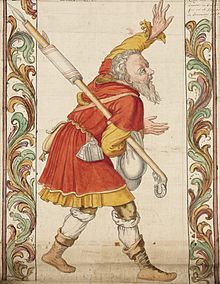George Ripley (alchemist)
|
Sir George Ripley |
|
|---|---|

Ripley, as illustrated in a 16th-century edition of the Ripley Scroll
|
|
| Born | c. 1415 |
| Died | 1490 (aged c. 75) |
| Nationality | English |
| Notable work | The Compound of Alchemy, Cantilena Riplaei, The Ripley Scroll (disputed) |
|
Main interests
|
Alchemy |
|
Influenced
|
|
Sir George Ripley (c. 1415–1490) was an English Augustinian canon, author, and alchemist.
George Ripley was one of England's most famous alchemists. His alchemical writings attracted attention not only when they were published in the fifteenth century, but also later in the sixteenth and seventeenth centuries. His writings were studied by noted figures such as the alchemist John Dee, Robert Boyle (who is considered to be the first modern chemist), and even Isaac Newton.
A great deal of myth has grown up around Ripley, such as that he studied in Italy for twenty years and became a favorite of Pope Innocent VIII. He did however spend a number of years on the continent, and after his return to England he wrote his work The Compound of Alchymy; or, the Twelve Gates leading to the Discovery of the Philosopher's Stone (Liber Duodecim Portarum) in 1471. The Cantilena Riplaei is one of the very first poetic composition on the subject of alchemy. Most of Ripley's work is based on the work of pseudo-Ramon Lull, although The Compound of Alchemy is based largely on the work of a little-known alchemist of the fifteenth century, named Guido de Montanor.
Another story about him is reported by Thomas Fuller in his Worthies of England,, which describes a reputable English gentleman who reported having seen a record in the island of Malta which stated that Ripley gave the enormous sum of one hundred thousand pounds sterling annually to the Knights of that island and of Rhodes to support their war against the Turks.
Ripley is known as the 'Canon of Bridlington'. He spent his later years as an anchorite near Boston (Yorkshire).
Some scholars claim that the writings of The Compound of Alchemy were meant to be read in light of an alchemical drawing done by Ripley called the Wheel. This drawing is in essence an analogy of the planets of our solar system, of which at the time, earth was considered to be the center. Ripley encoded his alchemical recipes into this drawing, depicting them as the planets which revolved around the earth, or, more specifically, the elements of his work. In alchemy, there is often an analogical connection made between heaven and earth, and this connection is symbolized by the use of the seven planetary symbols: Sol (Sun), Luna (Moon), Mercurius (Mercury), Venus, Mars, Jupiter, and Saturn. These planets correspond respectively to gold, silver, quicksilver, copper, iron, tin, and lead.
...
Wikipedia
